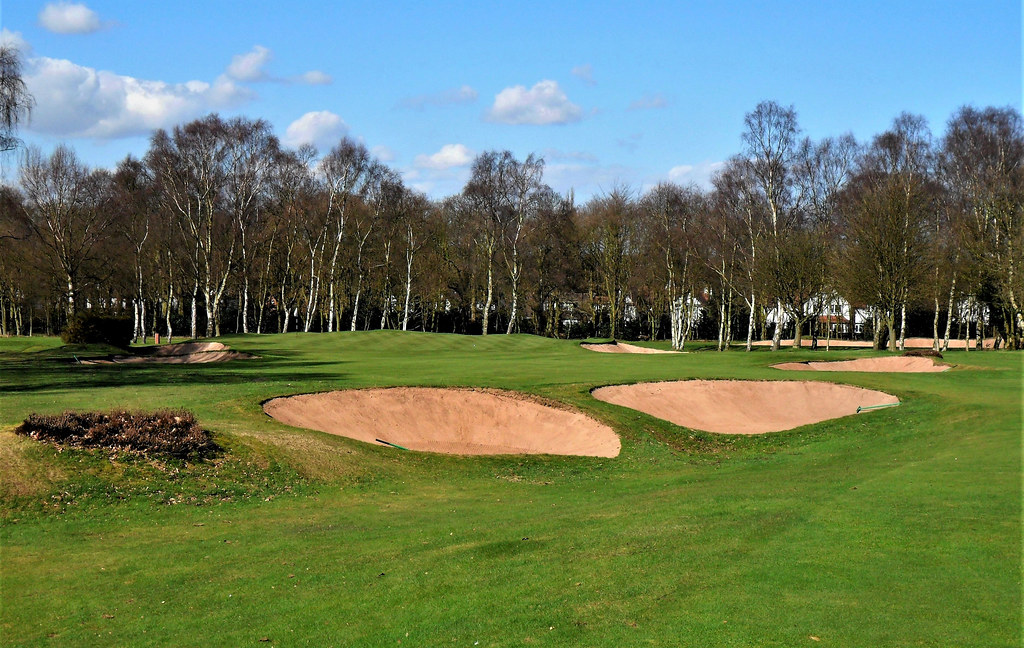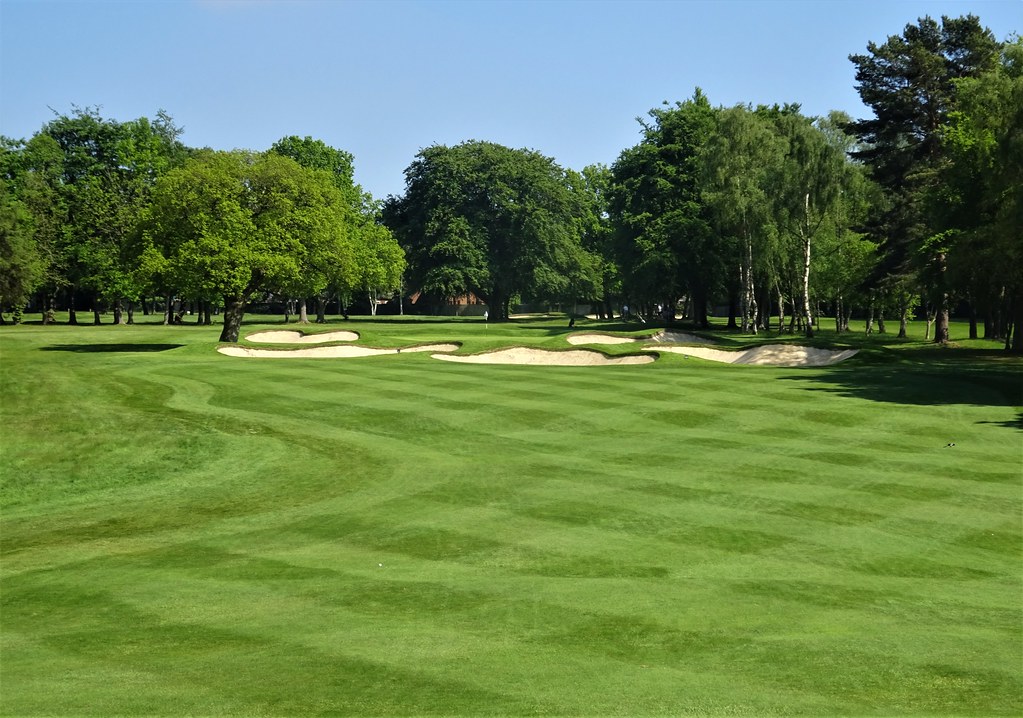
Long considered the premier club in the Midlands and a top parkland course in the country, Little Aston has hosted many amateur and professional events, including the Dunlop Masters, Brabazon Trophy and English Amateur. In 2008 the club celebrated its centenary and two years later major amateur golf was reintroduced to the club in the guise of the English Amateur for the first time since hosting the Ladies British Amateur in 1998. Opened in 1908, the original Harry Vardon design is routed mainly through grounds that at one time belonged to Little Aston Hall (adjacent to the 15th fairway and across the lake from #17). In the 80s the Hall was converted into luxury flats and later more apartments were added along with a private hospital. Importantly, none of this development can be seen or heard from the course. A relatively intact Vardon design with major bunker work carried out by HS Colt in the mid 1920s; Little Aston has been tweeked in recent years with added tees and revamped bunkers. Additionally, the 17th green was moved closer to the water on the left creating a much more demanding approach. The one hole we know Colt created is the tricky short 5th. It would have been a sight to see with original bunkers surrounding the green and no trees isolating it from the bunkers on #4.
The first impression upon arriving at the gates through the posh Little Aston Park neighbourhood is that of quality. The course is just off Roman Road, a section of the famed Icknield Street which was a Roman road running from the Cotswolds to South Yorkshire. The tranquility belies the fact that Little Aston lies within a few miles of Birmingham's hustle and bustle. The house is very tastefully decorated without being ostentatious. After playing the 1st hole that feeling of quality stays with us for the course is rather like a well kept garden and most certainly looks as though it belongs on this landscape. Some may mistake this air of genteel restraint as a sign that a good score can be had cheaply. On the contrary, for those who refuse to meet Little Aston on her terms a round of golf may seem an eternity of frustration. The chief causes of this would be anguish are the greens and bunkers. The putting surfaces tend to measure on the rather large side and many slide from front to back. The sand pits are sometimes immense and often conceal lines of play. The somewhat hilly terrain make shots play significantly longer or shorter and fairways often move a penny left or a penny right. In short, Little Aston is cunning and very good golf.

Image posted by C Georges
The opener is a gentle hole with a bit of a sting in its green end. The hole flows steadily downhill, but because the green is built up in the rear about 8 feet it is difficult to ascertain how severe the front to back slope is. Notice the shedding edges of the first green. Many of the greens feature this style of design which effectively make the greens play smaller.

The monster second plays straight back up the hill and through a myriad of bunkers; usually into the wind. We next come to the short par five 3rd. When combined with the 4th and 8th it forms a long avenue not unlike Swinley Forest's 6-8 run. In earlier times, this via of golf, which has now been cut off from the clubhouse by trees, was a particular delight of members. It would seem the club doesn't seem to mind burying not only views behind trees, but bunkers as well. I don't think its a particularly attractive combination, but it does serve the purpose of toughening up this relatively (for flat belly standards) short course. The second to this three-shotter demonstrates how much the course relies on bunkers to challenge golfers. The foreward left bunker was recently enlarged.

Many of the best courses have good sets of par 4s which are varied. Little Aston certainly falls into this category as the two-shotters are a marvel of diversity. The 4th is a lovely short two-shotter in which a long diagonal bunker hides the aggressive landing zone and thus the best angle of approach to this slippery front to back sloping green. This is a reachable two-shotter for some, but the gap to the green is at such an angle where the green shunts balls toward the back right bunker. A good drive can reach the far left bunker. For flags in the back right part of the green there is a hidden half of a bunker which is very much ready to gobble up overly aggressive approaches. This picture gives an indication of how penal and huge many of the bunkers are.

#5 is the first of a good set of short holes all of which play longer than they appear; this one because of the raised nature of the green combined with front bunkers. The 6th is a tough driving hole that calls for a fade around the right bunkers. Once again, we see bunkers being used to obscure the approach distance. In this case, if one can hit the drive far enough that element is nullified. While Little Aston is a parkland course it does enjoy some elements of heathland characteristics such as relatively good drainage and a scattering of heather here and there. With the course relying so much on bunkering for interest, I wonder if this is a situation where the two bunkers below should be removed and heather encouraged to flow across the ridge?

#7 is another tough driving hole which like many at Little Aston has the driving zone pinched by a bunker cutting into the fairway. Unfortunately, as on #4, some lovely earthworks are buried in trees. I believe this hole used to play more as a legger right over the large mound. The green is large and wraps around the front left bunker. The eighth is dead straight and features another front to back green. Another wonderful feature of Little Aston's bunkering is how many conceal additional pits further up the course. In the case, there are hidden bunkers greenside left and right. The short 9th makes no allowances for a shaped tee shot - only a straight, true shot will find the target.
In days gone by the golfer used to pass through a gate which signaled he was leaving the park to play a trio of holes which seem different from the other 15 holes. Up to this point, Little Aston has a very gentlemanly nature about it which abruptly comes to an end. It is not unlike Swinley Forest's or Beau Desert's 12th holes because this par 4 double doglegs as well. However, Little Aston takes the concept up a notch by requiring a far longer and more precise drive to have any hope of reaching the putting surface in two. One may think this is a gambler's hole, but playing for a 5 is a much better bet than opting to achieve a two putt par. This hole used to be far more brutal prior to trees being cleared on the left which left a gap and the right fairway bunker removed. Yet, it remains a formidable challenge. Not only is the 12th a 435 yard, double doglegger, but it also plays uphill, often into the wind, to what is surely one of the smallest greens on the course and over a newly restored large cross bunker. Indeed, some of the time, the bunker some 50 yards short of the green ise the main worry for the player lucky enough to have hit the fairway with his drive.



The best of golf design often centres around tempting the golfer. #11 is a tight legger left with the land moving right. One must hit a long drive to earn a view of the green. The hole has recently been cleared of a ton of debris, thus creating an enticement to drive straight at the green rather than follow the fairway.

It seems there isn't a single hole at Little Aston where the architects haven't used some sort of clever design method to put golfers on guard. A look at the green.

The 12th is the last of the three consecutive holes not in Little Aston Park and it also introduces water to the course. This reachable par 5 is spruced up with a water hazard guarding the lay-up area and approach to the green. The approach - gulp. Of course, I don't believe the water was created by Colt or Vardon. P Dickinson eludes to "improvements" in his " A Round Of Golf Courses" and that is what I believe we can put the water down to on this hole.

We now re-enter the park proper for the 13th. Changes are afoot at Little Aston. The club finally decided to remove the offending tree overly protecting the right side of the green. This crafty one-shotter is the best short hole on the course. It plays to a narrow green with flanking bunkers. What you can't see from the tee is the green is more protected than it would seem. A very long blind bunker guarding the right side of the green makes this hole play more difficult than one imagines on the tee. Before the tree removal.

Behind the green before the tree removal.

After tree removal.


If Little Aston has a famous hole the drivable par four 14th is it. There are a few spots on the course in which trees are egricious, the 14th is probably the most glaring example. There should at most be only a few trees down the right so the temptation of the green as a target is in sight. As the hole is now with a large scattering of unattractive trees, it is not only less attractive than it should be, it also offers less options. Finally, not having the back tee for the next hole in sight gives a false impression of safety. I would much prefer to see where golfers are located and take appropriate safety measures rather than hope that trees block a bad shot. For all this, the hole is a keeper. Due to the large diagonal hazard we only see the far left of the fairway which doesn't look particularly inviting. One's instinct is to fade a drive right over the bunker, but the key is get your ball to the far side of the fairway for the up the alley approach.

Sketch taken from A Round of Golf Courses by P Dickinson
Short-sided approach.

The 15th is a cracking par 5. If there is a tailwind the flat belly must decide if he can carry the bunker/hump complex. If he can the green is within reach of two blows. For the rest of us poor sods, we only have to make sure we don't hit into the crossing hazards. That said, often times the hole plays straight into the wind and in this case, it takes three good blows to reach this green 550 yards away.

"The greens of Little Aston are large, beautifully kept, and exceedingly cunning. They are such greens as Professor Einstein would delight to putt on - for there is no such thing a straight line however, superficially, it may appear so. The slightest of inclines, the subtlest, finest borrows and curling declivities bear the ball away to touch the hole like a tangential arc. I pause to allow Dickinson to bear witness to what my skills as a photographer cannot - and what better person to quote than the only writer I know of who could match Darwin for his prowess with the pen. The 15th green is one of the devils Dickinson describes.
#16 is one of those holes where there is loads of space off the tee. The golfer is tempted to bang away, but perhaps it is best to lay back for a better view of the green for the approach. Below is a look at the fairway from well in front of the tees. There has been subtle re-shaping of bunkers on this hole.


Many people question the presence of the two water holes, but I think they go a long way to providing variety at Little Aston. In both cases, the water must be taken on. The bunker in the foreground is very much in play off the tee and forces the player to make a decision; hit left in a less desirable position for the approach, layup short of the bunker or try to skirt one past the bunker.

Thankfully, the silly tree sapling past the bunker was removed.

The home hole takes us up our final climb and is tightly bunkered as well - what a surprise. Another cross bunker conceals the distance to the green and this one is mammoth! The other standout feature of the hole is a large specimen tree to the right of the green which guards rather than frames. This is rare instance of trees being used intelligently.

Little Aston is a lovely day's golf, but has been tagged as a course with too many holes which are a bit too similar. I suspect the aggressive use of bunkering and subtle greens may offer this impression. As a counter-point and interestingly, the reviews on offer from well known sources (Pennink, Finegan, Dickinson and Doak) all point to different holes as the best. Pennink cites 6 & 17, Finegan 3, Dickinson 8 & 14 and Doak 18. Furthermore, Lorne Smith believes 10 is the best hole! In addition, I believe holes such as 1, 4, 11 & 15 are more than merely good holes. The conclusion I draw from this discrepancy of opinion is that Little Aston not only has plenty of very good holes, but also great variety. Yet, Little Aston is essentially only as hard as the golfer chooses to make it. There are nearly always ways to avoid serious trouble yet one is asked to take risks on a great many of the holes. In a word, Little Aston is the essence of the gentleman's golf with an emphasis on gentle and fits in very well in terms of ambience and course quality with some of the great clubs of Surrey and Berkshire. I shall leave the last word to Patric Dickinson; "...I am not going to give detailed and meticulous directions how to get there, but, I think, as to Southwell Minster, the interested enthusiast will find his way there sooner or later and, without being extended to the utmost, will enjoy himself. Little Aston is in good taste and has good taste." 1* 2021
More Birmingham Beauties:
Edgbaston
http://www.golfclubatlas.com/forum/index.php/topic,40029.msg840362.html#msg840362Handsworth
http://www.golfclubatlas.com/forum/index.php/topic,29677.msg574488.html#msg574488Harborne
http://www.golfclubatlas.com/forum/index.php/topic,37526.msg772456.html#msg772456Moseley
http://www.golfclubatlas.com/forum/index.php/topic,48115.msg1081601.html#msg1081601Sutton Coldfield
http://www.golfclubatlas.com/forum/index.php/topic,51321.msg1336080.html#msg1336080Ciao